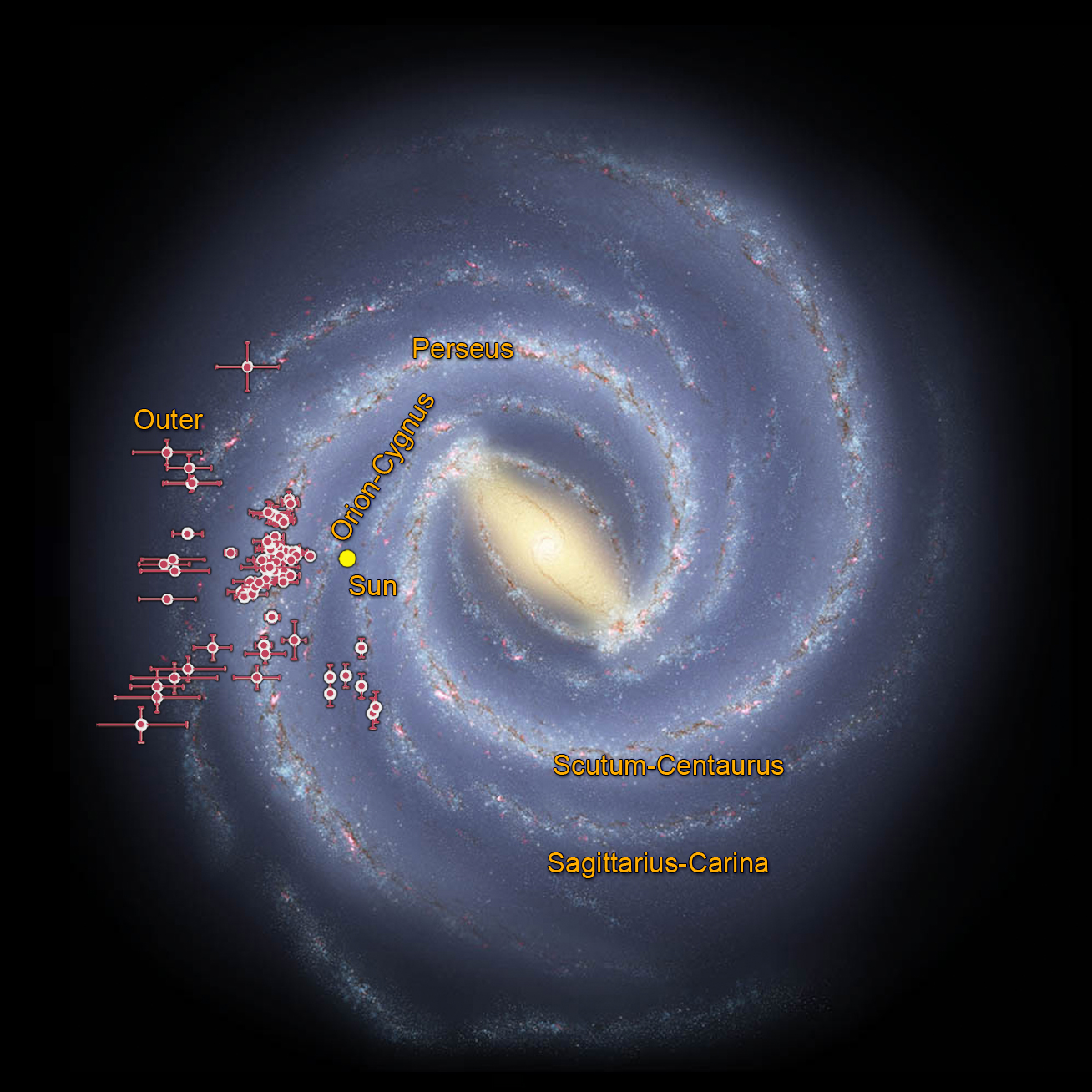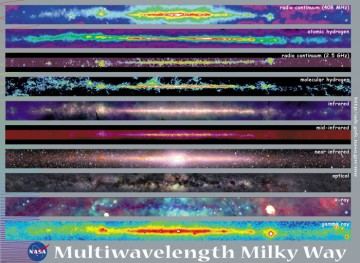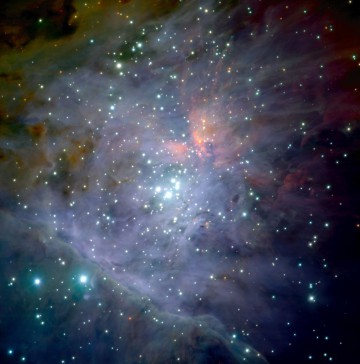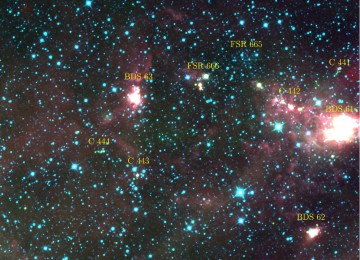
In the fictional universe of Star Trek, the entire Milky Way galaxy is mapped in great detail and divided into four quadrants, each one with its own set of alien civilisations that are at the center of the series’ drama. In real life, this level of detailed mapping of our home galaxy still is the stuff of science fiction, with only small portions of our galactic neighborhood being having been charted in any significant detail. A new series of observations from NASA’s WISE spacecraft now comes to enhance our view of the Milky Way, allowing astronomers to trace its spiral structure by unveiling hundreds of previously unseen star clusters that were embedded deep within molecular clouds of dust and gas.
Ever since Edwin Hubble established in the early 1920’s that our 100,000 light-year-wide Milky Way was just one of the hundreds of billions of galaxies that populate the Universe, astronomers have been struggling to find more about the nature and overall structure of our expansive galactic complex. Comparative studies with ground-based telescopes of the Milky Way with other galaxies during the mid-20th century, had indicated that our own galaxy is a spiral one similar to the emblematic Pinwheel Galaxy, or M101, which is one of the most-known spiral galaxies in the local Universe. But what is the exact structure of the Milky Way? Since our Solar System is located within the galactic disk we can’t obtain an overview photo of our galaxy from above similar to those of other galaxies that have been taken with the Hubble Space Telescope and other space observatories. Nevertheless, our position inside the galactic plane gives us the opportunity to study the stellar population as well as the great amounts of interstellar gas and dust of the Milky Way to an extent that isn’t possible for even the nearest galaxies to our own. In this way, astronomers can gather valuable clues for deciphering our galaxy’s overall structure and morphology.

The advent of space-based infrared astronomy coupled with a long series of comprehensive all-sky surveys with ground-based radio telescopes that have taken place during the last half century, have provided great views into the plane of the Milky Way by allowing astronomers to penetrate the dust and gas of the interstellar medium which hinders observations in the visible part of the electromagnetic spectrum. The Two Micron All-Sky Survey, or 2MASS, which was a ground-based all-sky infrared survey that was conducted between 1997 and 2001 yielded many important discoveries, including the detection of hundreds of brown dwarfs and low mass stars within the Milky Way as well as the discovery of previously unseen open star clusters which are formed inside giant molecular clouds. The latter are mainly composed of very young and massive O and B-type blue and white stars with ages that are not greater than a few dozen million years, thus representing a brief evolutionary step in the lives of stars. Since the bulk of the galaxy’s stellar population is thought to form inside such open groups, the detailed study of the latter is fundamental in understanding stellar and galactic evolution in general as well as the overall structure of the galaxy itself. NASA’s Spitzer Space Telescope has also been instrumental in this research effort. In 2005, the orbiting observatory made history by providing the first concrete evidence that the Milky Way isn’t just a simple spiral galaxy but a barred-spiral one instead, featuring a massive 27,000 light-year-wide bar that extends from its center. Subsequently, Spitzer caused much stir within the scientific community in 2008, when it returned tantalising evidence which had indicated at the time that the Milky Way might only have two major spiral arms instead of four as was previously thought to be the case. Then in 2013, the four-spiral arm picture of the Milky Way returned on the spotlight again, when the results of the all-sky survey in radio wavelengths revealed that our galaxy indeed had four spiral arms after all, each with a different stellar composition of old and read and blue and young stars respectively.
In their efforts to bring a greater consensus within the scientific community regarding the Milky Way’s true structure, a research team of astronomers from Brazil led by Denilso Camargo, an astronomer at the Federal University of Rio Grande do Sul in Brazil, conducted a comprehensive analysis of archival data that had been taken with NASA’s Wide-field Infrared Survey Explorer, or WISE. Launched in December 2009, WISE completed two high-resolution surveys of the entire sky at infrared wavelengths, before its hydrogen coolant eventually ran out in February 2011, allowing astronomers to discover hundreds of thousands of new previously unseen celestial objects within our home galaxy and beyond and peer deep into the massive molecular clouds of the Milky Way where star formation is actively taking place.

A sub-category of open star clusters is that of Embedded Clusters, which can be seen as the precursors of the former – very young stellar aggregations in the earliest stages of their evolution that are still heavily immersed in the massive interstellar gas clouds from which they were formed. Since embedded clusters have very short lifespans, in the order of a few million light years, they are excellent tracers of the Milky Way’s spiral structure inside which most of open star clusters lie. “It is widely accepted that spiral arms are the preferred sites of star formation and, as most stars form within embedded clusters, the arms are sites of cluster formation,” write the researchers in their study which was published in the May 20 online edition of the Monthly Notices of the Royal Astronomical Society. “Star formation may occur after the collapse and fragmentation of giant molecular clouds that occur within spiral arms transforming dense gas clumps into embedded clusters. Based on the absence of massive carbon monoxide-bright molecular clouds in the inter-arm space, [previous studies] argue that molecular clouds must form in spiral arms and be short-lived (less than 10 million light-years). Then, the spiral arms may be traced by young star clusters, especially embedded clusters that have not had enough time to move far from their birth places.” Operating under this assumption, Camargo team searched the WISE archives extensively, and was able to discover a total of 437 new embedded and open star clusters within the galactic plane, which allowed the researchers to put more constrains on the expected structure of the Milky Way.
Analysis of the WISE images as well as those taken with the 2MASS survey, revealed that in accordance with the results of previous similar studies, open clusters aren’t distributed randomly in interstellar space but follow a distinct spiral pattern instead that extends outwards dozens of thousands of light-years away from the center of the Milky Way across the galactic plane. The results of the recent study by Camargo’s team, which focused on seven of the newly discovered embedded clusters out of the total 437, showed that the latter were distributed along three of the Milky Way’s spiral arms, predominantly the Sagitarius-Carina, Perseus, and the Outer arm. “Most embedded clusters in the present sample are distributed in the second and third quadrants along the Perseus arm,” write the researchers in their study. “In this region, the Perseus arm is located at galactocentric distances in the range of 9 kiloparsec [approximately 29,000 light-years] in the second quadrant to 10.5 kiloparsecs in the third quadrant for a distance of the Sun to the Galactic Centre of 7.2 kpc [approximately 23,000 light-years], or in the range of 9.8–11.3 kpc for a distance of the Sun from the galactic center of 8 kpc…The Sagittarius–Carina spiral arm in the region traced by our embedded cluster sample is at a galactocentric distance of approximately 6.4 kpc [20,000 light-years]…In [previous studies] by Camargo et al. (2013), based on the distribution of embedded clusters we confirmed that the Outer arm extends along the second and third Galactic quadrants with galactocentric distances in the range of 12.5–14.5 kpc [40,000-48,000 light-years] for a distance of the Sun from the galactic center of 7.2 kpc…There is a large discrepancy between the stellar Outer arm and the gaseous Outer arm with a distance larger than 20 kpc [65,000 light-years], but it appears to be a common feature for large spiral galaxies.”

These new results by Camargo’s team come to complement a previous study by the same researchers, which recently unveiled the presence of two young open star clusters which were quite surprisingly found to lie approximately 16,000 light-years below the plain of the Milky Way, offering tantalising hints about our galaxy’s tumultuous history which possibly included great tidal interactions between the latter and its neighboring satellite galaxies, like the Large and Small Magellanic Clouds. “Our work shows that the space around the Galaxy is a lot less empty that we thought,” commented Camargo regarding the two newly found clusters far beyond the galactic disk. “The new clusters of stars are truly exotic. In a few million years, any inhabitants of planets around these stars will have a grand view of the outside of the Milky Way, something no human being will probably ever experience.”
As is always the case in astronomy and astrophysics, the study of a certain class of celestial objects, can provide great insights to other members of the cosmic zoo as well. “The Milky Way is our galactic home and studying its structure gives us a unique opportunity to understand how a very typical spiral galaxy works in terms of where stars are born and why,” says Dr. Melvin Hoare, a professor of astrophysics at the University of Leeds in the UK.
The detailed charting of the Milky Way galaxy as portrayed in the fictional universe of Star Trek may be the stuff of science fiction, but astronomers’ mapping efforts of our home galaxy in real life, nevertheless constitute a fine example of a science fiction concept that is slowly being turned into reality.
Want to keep up-to-date with all things space? Be sure to “Like” AmericaSpace on Facebook and follow us on Twitter: @AmericaSpace




